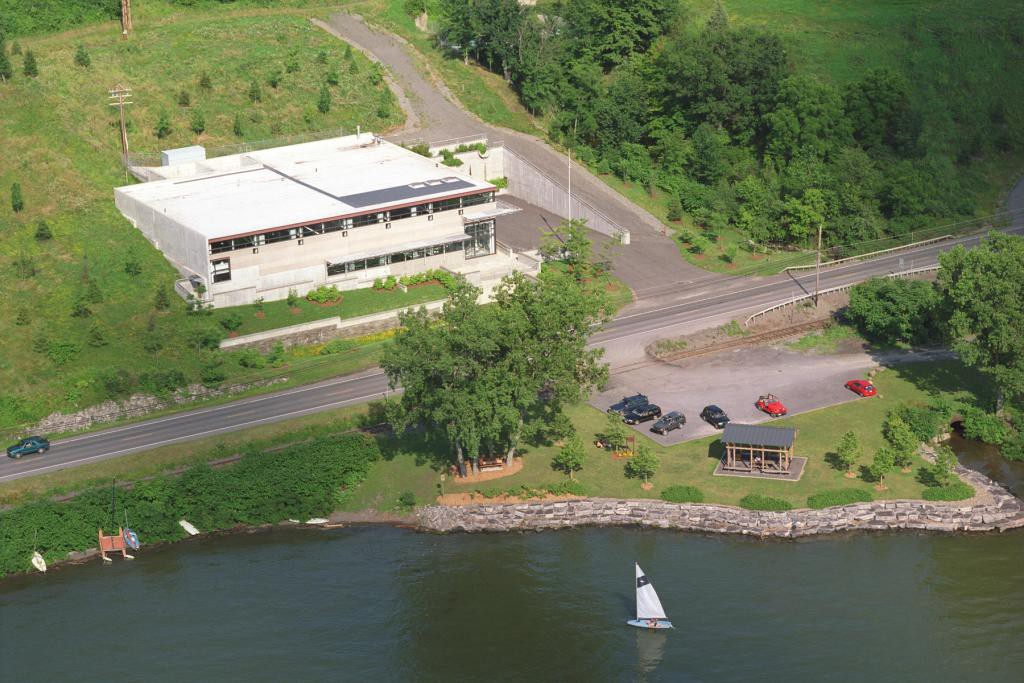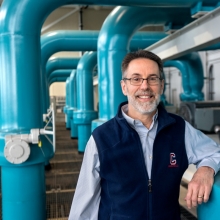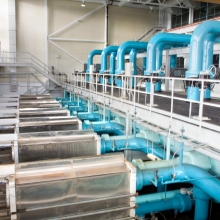
Adapted from Medium article published by Cornell University | May 10, 2017
Cornell’s Lake Source Cooling facility has been in operation for over 15 years, providing the campus with low-carbon, clean cooling, direct from Cayuga Lake, and remains one of the most significant environmental initiatives ever undertaken by an American university to promote a sustainable future.
A Historical Commitment
Lake Source Cooling (LSC) launched in 2000. The facility represented a massive, new investment in a central campus chilled water system, to create an environmentally sound design that conserves energy and uses a renewable resource: the deep, cold waters of Cayuga Lake. It was a transformation with a price tag of $58.5 million — a significantly higher cost than simply replacing the existing chillers with new ones.
But sustainable design includes longevity. LSC system is designed to last 75 to 100 years, more than twice the typical life of chillers, although facility directors indicate the facility could last up to 150 years.
The project is cost-effective, and helps Cornell reach its carbon neutrality goal because of its energy savings, long life and replacement of outdated chillers containing CFCs. Since becoming operational in July 2000, LSC has saved an average of 25 million kilowatt-hours of electricity per year versus previous cooling methods — enough to supply electricity continuously to 2,500 homes in Tompkins County.
LSC provides the university with a method of cooling that eliminates refrigeration equipment and its associated energy use, drastically lowers the environmental impact from energy generated by power plants using fossil fuels, and avoids future problems with the new generation of refrigerants designed to replace chlorofluorocarbons (CFCs). Since its inception, LSC has won seven major state, national and international awards, including the 2002 New York State Department of Environmental Conservation Governor’s Award for Pollution Prevention.
Seeking a New Approach
In 1993, Lanny Joyce, director of utilities and energy management and the LSC project manager, analyzed the potential costs and benefits of a lake source cooling system and concluded that while the project’s cost would be substantial, it was less expensive in the long run than upgrading the cooling system already in place.
After several months of research and review the project was formally proposed in 1994 and approved by the New York State Department of Environmental Conservation (DEC) in 1998. Nearly four years of environmental study and review resulted in a four-volume, 1,500-page Environmental Impact Statement that detailed the potential impacts of the project on the lake. The DEC determined that LSC could provide the stated environmental benefits without harm to Cayuga Lake. Even so, Cornell agreed to include many special features in the construction and operation of the project to further minimize risk of an adverse impact, including nearly a decade of lake monitoring.
Unprecedented Collaboration
No project of this size and complexity could be executed without collaboration on a scale equal to the task. This type of collaboration between faculty and facilities engineers was unprecedented at Cornell.
“Cornell faculty led and performed our scientific oversight to ensure that all the science done to identify, characterize and mitigate environmental impacts was world class and correct,” says Joyce. “They oversaw, and some helped perform the work associated with studying water chemistry, biological, thermal and short-term construction impacts from the project.”
Cayuga Lake Modeling Project
The LSC project is overseen by a faculty advisory committee that includes Todd Cowen, director of the DeFrees Hydraulics Laboratory and the Kathy Dwyer Marble and Curt Marble Faculty Director for Energy at the David R. Atkinson Center for a Sustainable Future; Cliff Kraft, associate professor of natural resources; and Hairston.
Hairston, who is regarded as one of the world’s leading experts on how lakes function, has served on the faculty advisory committee since 1994 and helped write a report at the beginning of the project on the possible environmental impact LSC might have on the lake.
Benefits for the local community
In exchange for an easement to cross the property belonging to the Ithaca City School District, the university agreed to provide cooling for Ithaca High School for the life of the project, providing more than $1 million in long-term benefits in addition to reducing electric energy use for cooling by 90 percent. Cornell also provides a direct fiber-optic Ethernet link from the university to the school district to promote collaboration between faculty and the Ithaca schools. Each year, students from Cornell, Ithaca and the surrounding area tour the LSC facility and learn firsthand about its environmental benefits, technology innovation and how they can help create a sustainable future.
The university also spent more than $1 million to install new water and sewer lines, storm drains, curbs and sidewalks along streets between Fall Creek and West Avenue, and for easements across private property. In addition, a small public park — the only town of Ithaca park on Cayuga Lake — was created across Lake Shore Drive from the LSC facility. These steps and more put a clear, tangible benefit to the local community “right in people’s hands,” Joyce says.
Construction of LSC included several local contractors and trucking companies. Payroll associated with construction jobs during a two-year period exceeded $10 million, and local and regional purchasing surpassed that figure by several million dollars. All backfill materials, concrete and landscaping materials were purchased locally.
“It’s not enough to just say you’re going spend money on construction,” Joyce says. “You have to provide real benefits.”
Glimpsing a Carbon-Free Future
In addition to keeping state and local stakeholders informed, Cornell project team members prepared scientific papers for publication in peer-reviewed journals to keep the larger scientific community apprised of major findings and implications for lake management. The project benefited from and supported the work of faculty, postdoctoral research associates, and graduate students in various Cornell colleges and programs, in alignment with the university’s commitment to envisioning campus facilities as a “living laboratory.
Campus energy needs account for nearly two-thirds of Cornell’s greenhouse gas emissions. Since 2009, Cornell has reduced its carbon dioxide emissions by more than 30 percent through not only LSC and aggressive energy conservation, but through constructing a new combined heat and power plant, eliminating the use of coal and building solar farms. The comprehensive Energy Conservation Initiative at Cornell focuses on ways to reduce carbon dioxide emissions from energy use in a cost-effective manner, working first to reduce energy demand, then improve energy performance.



